Northern Alligator Lizard (original) (raw)
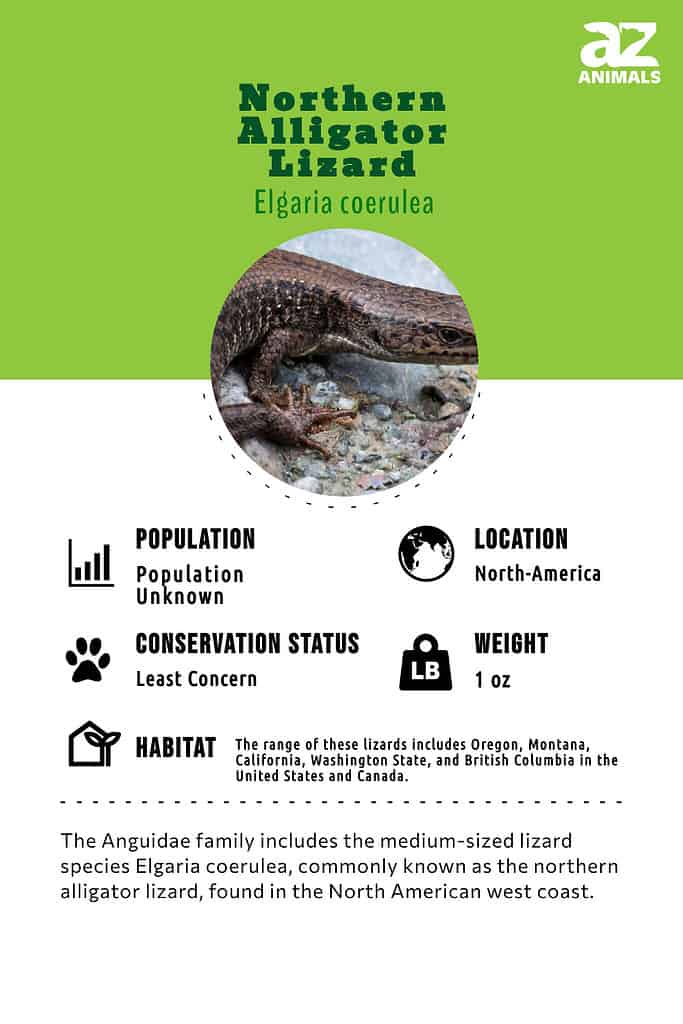
The Anguidae family includes the medium-sized lizard species Elgaria coerulea, commonly known as the northern alligator lizard, found in the North American west coast.
“The tail of the Northern Alligator Lizard can break off, then grow back again”
Northern alligator lizards are carnivores with a diet of crickets, mealworms, spiders, and sometimes baby mice. They earned their name because their scale pattern and short legs are similar to an alligator’s. These lizards live in a forest habitat mostly in rocky areas where they can hide. Northern alligator lizards have a lifespan of up to ten years and sometimes live longer. This small reptile is sometimes kept as a pet.
5 Incredible Northern Alligator Lizard Facts!
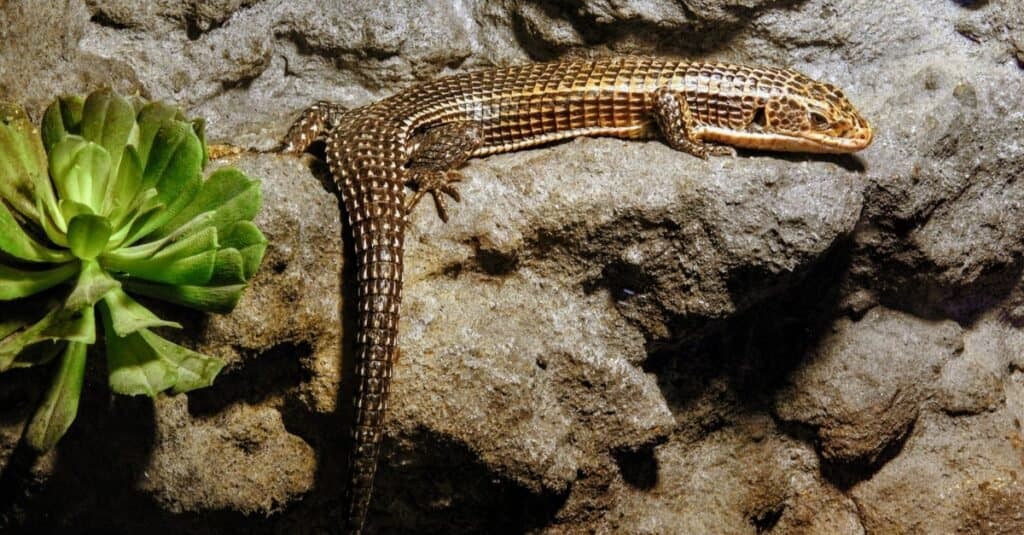
The lizard’s tail contributes approximately six additional inches to its overall length.
©Dana.S/Shutterstock.com
- These lizards give birth to live young
- The tail of this lizard adds around six inches to its size
- Some of its predators include hawks, owls, snakes, and weasels
- These reptiles live in Montana and other northwestern states in the U.S.
- They can have a litter of up to 15 babies
Scientific Name
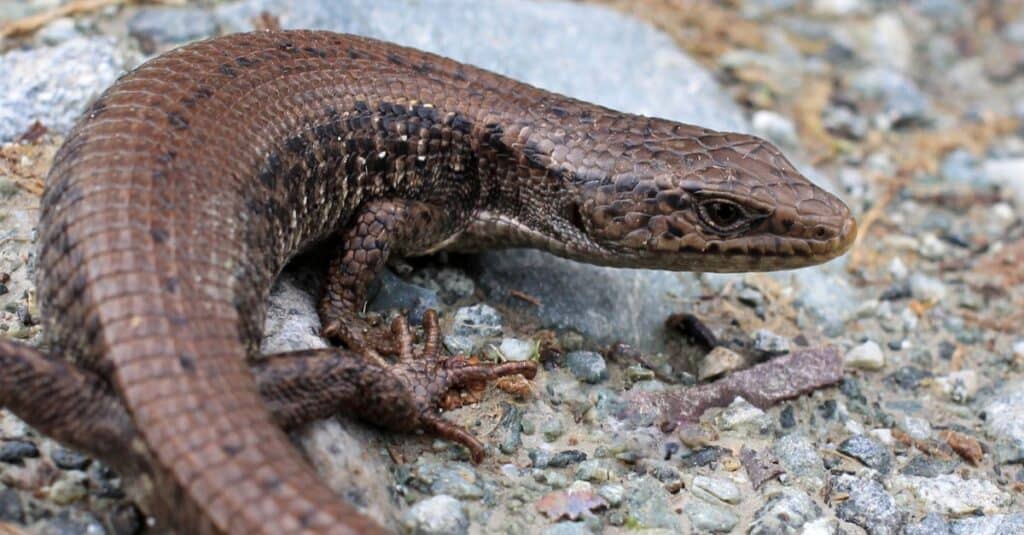
Wild Northern Alligator Lizard
©Randy Bjorklund/Shutterstock.com
The scientific name of the northern alligator lizard is Elgaria coerulea. The Latin word Elgaria refers to alligator and the word coerulea refers to the dark colors of its scales. They belong to the Anguidae family and the class Reptilia.
There are 67 species of alligator lizards worldwide and four subspecies of northern alligator lizards. The four subspecies include:
- Sierra alligator lizard
- San Francisco alligator lizard
- Northwestern alligator lizard
- Shasta alligator lizard
Evolution and Origins
The North American west coast is home to the northern alligator lizard (Elgaria coerulea), a medium-sized lizard species belonging to the Anguidae family.
The name “alligator lizard” derives from the fact that the dorsal and ventral scales of these lizards are strengthened by bones, similar to alligators.
When threatened, the alligator lizard can shed its tail, which will continue to move on the ground and distract the predator, but the tail will grow back without causing any harm to the lizard.
The distribution of alligator lizards ranges from southern British Columbia and the northwestern United States to Panama, with Elgaria and Gerrhonotus being found in the northern temperate zone and Abronia, Barisia, and Mesaspis being largely tropical or subtropical in distribution.
Appearance and Behavior
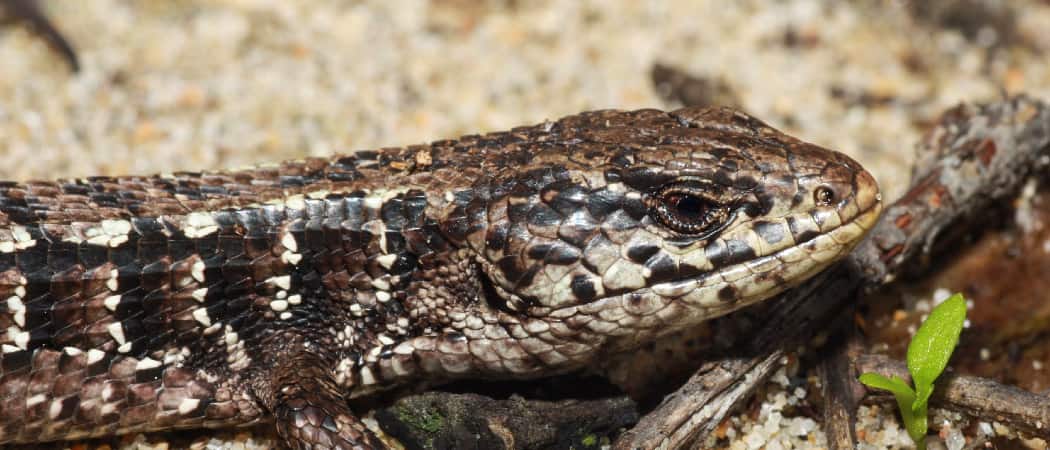
The dorsal side of a northern alligator lizard is adorned with a pattern of light brown and black scales, while its ventral side is covered in gray scales.
©Michael Benard/Shutterstock.com
A northern alligator lizard has a pattern of light brown and black scales on its back and gray scales on its underside. This reptile has short legs with five tiny claws and a long snout. When it comes to size, a full-grown northern alligator lizard reaches a length of three to four inches.
Its tail tacks on another six inches to its overall size. These reptiles weigh around an ounce. Take four and a half golf tees and line them up end to end. This line of golf tees is equal in length to a ten-inch northern alligator lizard (body and tail).
A translucent veiled chameleon is a similar reptile that can grow to be ten inches or longer as an adult.
The smooth-headed alligator lizard is the biggest of this type. This lizard’s body can measure up to 8 inches.
This small reptile has a long predator list. Though it is not poisonous or otherwise dangerous, it does have some ways to protect itself. For one, its brown and black scales help it to blend into its forest or rocky habitat.
In addition, if this lizard is attacked by a predator, its tail can break off allowing the lizard the opportunity to escape. One of the strangest facts about this little reptile is it can regrow its tail. Though it may not be as long as its original tail, it will work just as well.
These lizards are solitary except during breeding season. They are shy animals that would rather stay out of sight. When they see a predator, they either hide or run away.
Habitat
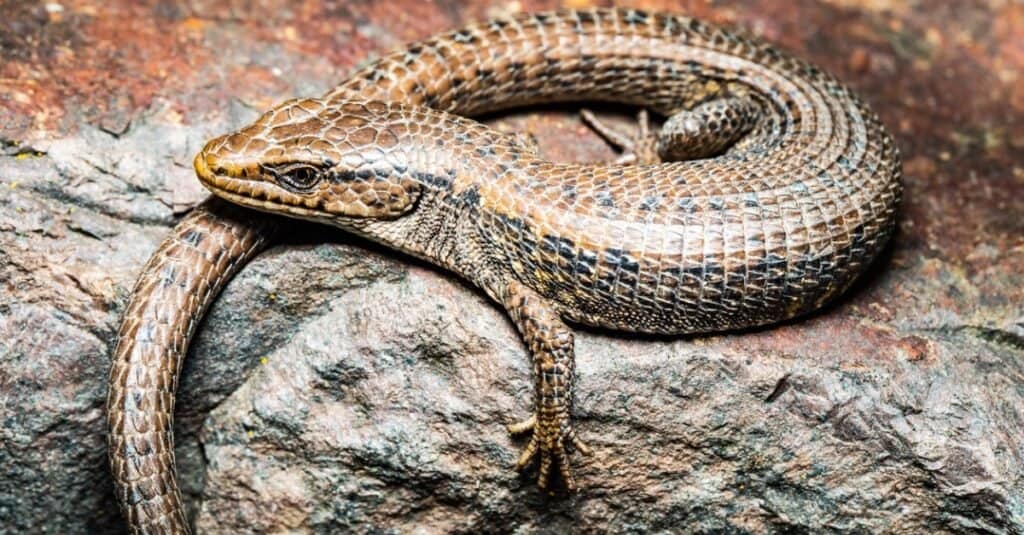
These lizards are native to the United States and Canada, inhabiting regions including Oregon, Montana, California, Washington state, and British Columbia.
©iStock.com/Jeff Huth
These lizards live in the United States and Canada. Specifically, they are found in Oregon, Montana, California, Washington State, and British Columbia. Their habitat includes rocky areas of forests. They are sometimes found living in urban areas in the cracks of buildings or other structures. These reptiles thrive in a temperate, semi-moist climate.
Though these reptiles spend a lot of time on the ground looking for insects and other prey, they can also climb trees. One of the most interesting facts about this creature is its tail helps it to balance and hang onto twigs and small branches as it climbs.
Predators and Threats
These reptiles are carnivores. The size and type of prey they eat depend on what is most plentiful in their habitat. They look for food in the trees and on the ground during the daytime.
What eats northern alligator lizards?
Hawks, owls, weasels, and snakes are all predators of these lizards. A domestic cat in the area may also be a predator of this tiny reptile. All of these predators can climb trees making it harder for this lizard to escape.
What does a northern alligator lizard eat?
This reptile has a diet of crickets, beetles, mealworms, and other insects that are not poisonous. They also eat larger prey such as baby mice. Someone who keeps a northern alligator lizard as a pet may purchase frozen insects to feed it.
The conservation status of this reptile is Least Concern with a stable population.
Though the main threat against the northern alligator lizard is habitat loss, this animal is known for adapting to its circumstances. While it usually lives in say a Washington State or Montana forest habitat, it can also live in the cracks of an old building or wall in an urban environment. It has adapted to living successfully in different environments.
Reproduction and Life Cycle
The breeding season of this reptile takes place from April to June. A male northern alligator lizard searches for a new female every breeding season. When a male finds a female it wants to mate with it grasps the female’s neck with its mouth to keep her in one place. The gestation period of the lizard is around 11 weeks. They have their young anywhere from late June through the month of September.
A female breeds every two years. Females can give birth to as many as 15 babies, but most have four or five per litter. These alligator lizards give live birth to their young. This is notable because most reptiles lay eggs. Though these baby lizards don’t hatch from eggs, they are sometimes referred to as hatchlings.
As a comparison, another reptile called Jackson’s chameleon has a gestation period of four to six months, and it can give live birth to as many as 30 babies at one time.
A baby northern alligator lizard is born with the capability of living independently from the start. The mother doesn’t need to feed or provide care for her young. The babies proceed out into their habitat to look for beetles and other small prey.
The lifespan of this lizard goes up to 10 years.
Population
The exact population of these alligator lizards is unknown. But biologists estimate there are more than 10,000 mature individuals.
Their conservation status is Least Concern, and they have a stable population.
View all 87 animals that start with N
These lizards are carnivores.
While these lizards do bite sometimes, they are not considered dangerous. Though their bite is not poisonous, it can be painful. This is something an individual should consider before keeping this type of lizard as a pet.
One other thing to keep in mind is these reptiles can sometimes carry salmonella. This is why it’s important for a pet owner to wash their hands after handling this lizard. Someone who is infected with salmonella via a pet lizard may experience upset stomach and fever.
The size of an adult northern alligator lizard’s body can measure three to four inches. Its tail adds on another six inches to its overall length.
Northern alligator lizards eat a diet of spiders, crickets, mealworms, and beetles. They may also eat baby mice if there are not enough insects in their habitat.
A northern alligator lizard is not an ideal choice for a pet. These tiny reptiles can become stressed while being handled by an owner. So, if kept as a pet, a northern alligator lizard would be more at ease remaining in its aquarium habitat. This may not appeal to someone who wants to care for a pet that likes being handled.
Also, the temperature has to be monitored in the aquarium so this cold-blooded animal stays warm enough at all times. In addition, this lizard has a lifespan of up to ten years, so an owner is taking on a long term commitment with this type of pet.
Lastly, an individual who understands the unique care required for this lizard may enjoy keeping it as a pet.